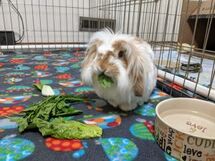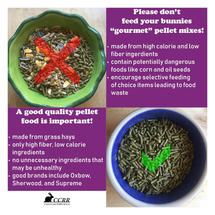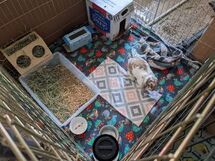Getting started with a rabbit
So, you've just gotten yourself a rabbit, and you're a little overwhelmed at all of the information out there. This page is an effort to provide cursory information and to link to key resources that you need in order to get off to a good start and give your bun a happy, healthy life. A good article to first look at is batclock's New Rabbit Owner Primer. If you'd rather build a physical library of useful bunny books, see Useful books on rabbits.
What do I feed my bunny?
Rabbits eat approximately 30 times per day (2 to 8 grams of food per time) over 4 to 6 minute periods.[1]
The basic diet of an adult rabbit is a combination of hay, pellets, and vegetables. The main portion of their diet should be unlimited access to a high quality grass hay like Timothy hay, which is high in fiber and low in calories. Other grass hays like orchard grass or oat hay are acceptable alternatives; alfalfa hay should not be fed to adult rabbits as a main portion of their diet due to its high calcium levels.[2]
Baby rabbits have different diet requirements -- see Diet for details. Vegetables should not be introduced until 12 weeks old. They should get unlimited alfalfa hay and pellets until they are around 7 months old, when they should be transitioned to an adult rabbit diet. The large amount of high-calcium and high-protein feed allow the babies to grow big and develop strong teeth and bones.
If you obtained a baby rabbit under 8 weeks old, please be extremely careful of introducing any new foods as their digestive systems are still developing, and they are at high risk of developing enteritis due to stress and changes in diet. They should ideally still be drinking milk and living with their mother until naturally weaned around 8 weeks, but if your baby rabbit is already on hay and pellets and any other solids, continue the same diet with no change until they are older - there is no need to additional supplement any formula or milk.
Optimally, you should be feeding the same brands of food as the breeder or organization where you obtained the baby rabbit from. If you would like to transition their pellets to another brand, increase the amount by 25% per week and make sure their poop continues to look normal. Any diarrhea is an emergency, and the baby rabbit should be seen by a rabbit-savvy veterinarian for fluids and treatment.
Rabbits should always have access to clean, fresh water. They should also be regularly fed a variety of vegetables, such as dark leafy greens to provide a variety of tastes and textures as well as additional nutrients.
Pellets should be provided to supplement your rabbit's diet. While it is possible to go on a pellet-free diet, pellets serve as an easy calorie-dense nutrient source to insure a balanced diet with all necessary minerals and vitamins that would be difficult without a large amount of hay and vegetable diversity as well as outdoor sunlight access.
The problem with these foods is that each type of seed or ingredient has different nutritional content, and pets develop preferences for certain seeds or pieces. They can easily develop a deficiency when they become “picky eaters” and only eat certain parts of their food.
While hay and water should always be available in unlimited amounts to your rabbit, greens and pellets can be scheduled to be fed arbitrarily through the day as long as daily portions are appropriate. Some like to feed half the pellets in the morning, veggies in the evening, and half the pellets again before bedtime. Others like feeding veggies twice a day and pellets once a day.
On occasion, you may also choose to give your rabbit treats. Many pet stores carry treats marketed for rabbits, but pellets, fruits, herbs, and naturally sugar-loaded vegetables often make better and healthier treats.
Where should my bunny live?
A variety of housing options exist for rabbits, including cages, enclosures (i.e. x-pens), and free range. In all cases, the area housing your rabbit should be large enough for your rabbit to comfortably stretch out, hop around in, and to periscope his surroundings on his hind legs. Rabbits are also easily litter trained in many cases, so the enclosure should include at least one litter box.
Be careful of cages with a wire floor. Rex, heavy breeds, and poorly bred pet rabbits with thinly-furred feet are especially prone to sore hocks in wire-bottomed cages due to the uneven pressures of the wires. Additionally, untrimmed nails and toes can get caught in inappropriately-sized holes and be broken. If you use a cage with a wire flooring, you should provide a resting mat for your rabbit to sit on. If a rabbit is litter-trained, there is honestly no reason to need a wire-bottomed cage.
If your rabbit is not free roam or has a sufficiently large (>24 sq ft) permanent living space, they will need at least four hours of exercise every day where they can run and hop freely.[4] Make sure you bunny-proof any location that your rabbit is able to access and supervise to make sure they aren't eating anything they aren't supposed to.
The first day you bring your rabbit home, you should leave them alone in a prepared enclosure with hay, food, and water for a few hours to let them de-stress from the big change in environment and hopefully eat and poop on their own. If your rabbit has not eaten or pooped within 8-12 hours or your baby rabbit is producing diarrhea instead, please consult a rabbit-savvy veterinarian as an emergency. You may be dealing with stasis, enteritis, or coccidia, all of which will need urgent treatment.
How do I play with my rabbit?
There are many ways to keep a rabbit entertained and non-destructive. Take a look at our Toys and games article for ideas. Rabbits can also be clicker trained like cats and dogs to do tricks.
If you are having issues bonding with your rabbit, check out our FAQ question How do I make my bunny like me?
In general, rabbits do not like to be handled with their feet off the ground. Rabbits like it best when you come down to their level and interact with them on the floor instead.
What about medical care in my area?
Not all veterinarians are equal. Many veterinarian clinics will specialize in dogs and cats but may not staff a veterinarian who is knowledgeable about rabbits. It is important that before you bring your rabbit home that you have a good rabbit veterinarian picked out. Many times, local rabbit rescues or House Rabbit Society chapters will list area veterinarians who specialize in rabbits. You can find out more about rabbit savvy vets at our article Choosing a rabbit veterinarian.
Be forewarned that you should always have money saved up or apply for veterinary credit lines or pet insurance to help with regular and emergency medical care. Ask around for prices for typical procedures and problems and be prepared to spend the money to save your rabbit during a health crisis. Typical costs for one vet visit can range from US$40 to over US$300. Please understand that there usually is no replacement for proper medical care and consider the comparatively higher cost of a rabbit's medical care to a cat or a dog before getting one as a pet. You can find a global community database of example rabbit veterinary bills here for an idea of how much veterinary appointments may cost for different issues.
However, in the case that you are unable to obtain enough money due to extenuating circumstances, can provide a proof of income, and are still willing to take your pet to the veterinarian, explain your financial situation to the vets that you contact and see if you can mutually work something out. Otherwise, contact local shelters and rescues to see if they can help subsidize your bill or direct you to a fund that will. See more resources in the Financial assistance section of our vet article.
Please check and see what yearly vaccinations may be needed against certain fatal diseases common in your country. In Australia, your pet rabbit should be vaccinated for VHD at 10-12 weeks of age.[5] This vaccination will need to be renewed every year. In the UK, your rabbit will need vaccinations for both VHD and Myxomatosis. In the US, you may be able to get the VHD vaccine if you live in a state that has approved the Medgene vaccine. Please find more resources in Vaccinations.
How do I travel with my pet?
Traveling with a rabbit can be tricky. Rabbits are easily stressed, and traveling with one can take more planning than traveling with a cat or dog. For most trips to a veterinarian, you will only need to transport your rabbit in a carrier. For longer road trips, it is advisable to also pack enough food and water for the duration of the trip, a cage or other enclosure, and a litter box and accessories. Additionally, you should also pack some first aid for GI treatment in case your rabbit becomes unexpectedly ill.
If you plan on going on a prolonged vacation or trip, be sure to consider local resources for rabbit-savvy pet sitters or boarding businesses to watch your rabbit(s). See Going on vacation for more resources on the topic.
Why does my rabbit ____?
Bunnies can be peculiar pets and are full of little quirks. Answers to many common behavioral questions can be found in the Behavior FAQ. See Understanding your rabbit for common rabbit language and behavior problems that may arise. See Personalities for common rabbit personalities.
Any other concerns?
Remember to keep up with grooming your rabbit regularly to brush their fur and trim their nails. Rabbits will usually molt off their coat 2-3 times a year - it is especially important to keep up with brushing during this time to prevent stasis from your rabbit ingesting too much of their own fur while self-grooming. Excessively long nails can break off and predispose your rabbit to sore hocks. Check out Wellness check to learn what sort of regular diagnoses you should learn to regularly do with your rabbit.
Spay or neuter your rabbit when they are old enough! It is especially important if you have obtained two or more unfixed rabbits. Keep your rabbits separate until they are fixed unless they have been professionally sexed by a rabbit-savvy veterinarian to be the same sex - rabbits can be easily mis-sexed by an inexperienced handler. Rabbits can be sexually mature as early as 10 weeks and can get each other pregnant upon a successful three-second mating.[4] You may easily obtain an out-of-control rabbit population on your hands. Sexual maturity may also bring on territorial and aggressive tendencies which can cause fatal injuries in fierce fights, and any bonds between young rabbits may break as their scents change from hormones. Please do not intentionally breed your rabbits with the already multitudes of abandoned shelter rabbits.
If you only obtained one bunny, when they have been fixed, you may want to consider bonding your rabbit with another rabbit if you feel like you do not spend enough time to play with them or feel that they are overly destructive or bored. Rabbits are social animals and can be much happier and more well-behaved when they have a friend. Please wait until your first rabbit has been neutered for at least a month before obtaining another rabbit and speed-date them if possible to find a good match. Not all rabbits will easily get along, and some rabbits may need to be kept apart indefinitely for their safety.
Take a read through Veterinary emergencies to understand when a rabbit's abnormal behavior is a serious cause for concern, and the rabbit should be taken to a rabbit-savvy veterinarian as soon as possible. Gastrointestinal stasis is a common issue with rabbits and can occur at any moment with or without obvious triggers. If left untreated, it can be fatal in 48 hours.
We also recommend looking through our First aid guide for instructions on how to react to urgent issues like major skin wounds and choking.
Healthy rabbits should never need to be bathed in water. If your rabbit gets dirty, first use a damp towel or dry bath methods before resorting to using water to rinse and clean.
Lastly, you may find out about trancing your rabbit by laying them on their back. Read the Trancing article to understand the controversies and potential dangers of doing so.
Further reading
- House Rabbit Society. (2013). Living with a House Rabbit
- Mary E. Cotter. (2003). 10 Point Primer for New Bunny Parents [PDF]
- House Rabbit Society. (2002). 9 Common Rabbit Myths [PDF]
- Kathy Smith. Preparing for Your New Family Member [PDF]
- RSPCA. (2011). Rabbits: Good practice for housing and care [PDF]
- House Rabbit Connection, Inc. (2007). HRC Rabbit Care Guide
See also
- Costs of rabbit ownership
- Deciding on a rabbit
- New Rabbit Owner Primer
- Wellness check
- Useful books on rabbits
References
- ↑ Quesenberry, K & Carpenter, J. (2012). Ferrets, rabbits, and rodents: Clinical medicine and surgery. (3rd ed.).
- ↑ Varga, M. (2013). Textbook of rabbit medicine. (2nd ed.).
- ↑ Town & Country Veterinary Hospital, Charlene Arendas, DVM, Quick Tips for Rabbits and Guinea Pigs
- ↑ 4.0 4.1 Harcourt-Brown, F. (2001). Textbook of Rabbit Medicine. (1st ed.).
- ↑ Warringah Council. (2016). Caring for Your Rabbit. Retrieved 7 March 2016 from http://www.warringah.nsw.gov.au/sites/default/files/documents/general-information/rabbits/rabbitdl.pdf






